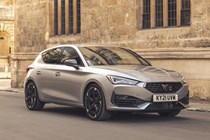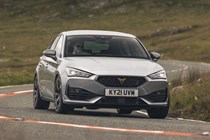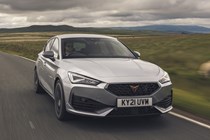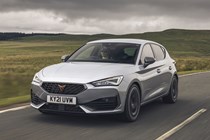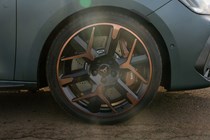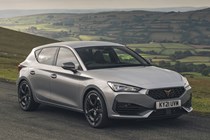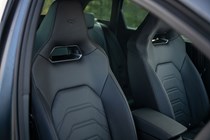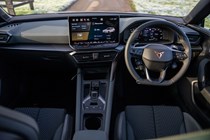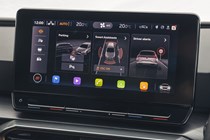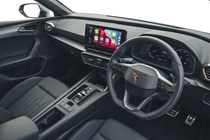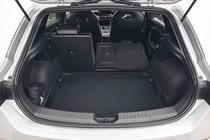
Cupra Leon running costs and reliability

Miles per pound (mpp)
| Petrol engines | 5.2 - 7.8 mpp |
|---|---|
| Plug-in hybrid petrol engines * | 6.5 - 8.0 mpp |
Fuel economy
| Petrol engines | 35.8 - 53.3 mpg |
|---|---|
| Plug-in hybrid petrol engines * | 44.1 - 54.3 mpg |
- Less economical than the SEAT Leon
- PHEV makes some outlandish claims
- 300hp version can be economical
What are the running costs?
Naturally, the 1.5-litre petrol offers the best fuel economy of the two petrol engines. When teamed with the standard six-speed manual gearbox, Cupra says it’ll return between 45.6 and 48.7mpg. The automatic bumps those figures up to between 47.9 and 51.4mpg, as it has an extra cog and mild hybrid assistance.
But even the 300hp model isn’t too inefficient for a performance car. Cupra says it can achieve between 35.8 and 37.2mpg on the WLTP cycle – and we saw figures in the mid-30mpg range when cruising along the motorway. However, if you step on the loud pedal often (which you’ll want to because it’s fun) those figures will quickly tumble.

Cupra says the PHEV-powered Leon is much, much more efficient. In official tests, it returned an utterly incredulous 706.2mpg, which you’ll never achieve in the real world unless you only ever potter around on the electric motor (which is difficult).
You need to make sure you’re religiously charging the battery to get the best from the system as, if you let it run flat, your fuel economy will drop to around 50mpg as penalty for hauling around the dead weight of the hybrid system.
Servicing and warranty
Cupra has three tiers of service packages. Its Level One plan covers the cost of two oil changes and a pollen filter replacement. You pay for it in 24 instalments of around £5.
Step up to Cupra’s Level Two plan and you’ll also get a new set of wiper blades and a fresh set of front brake pads. It’s broken down in 24 monthly payments of around £16.
Cupra’s most expensive Level Three service package covers you for everything above, plus a brake fluid change and an MOT. It’s spread across 36 monthly payments of around £22.
Cupra recently improved its warranty offering, too. Now, every Cupra Leon leaves the dealership with a five-year/90,000-mile warranty. That’s better than the three-year/60,000-mile warranty you get with the Volkswagen Golf GTI Clubsport or the three-year/90,000-mile package Honda offers on the Civic Type R.
Reliability
- Proven Volkswagen running gear
- Four recalls for the SEAT Leon…
- … but none for the Cupra Leon yet
The SEAT Leon has had four recalls since it was launched, the most serious of which was an issue with the seat belt anchor points in 2021 that affected 346 vehicles. Cupra (as a brand) hasn’t had any recalls according to the DVLA website.
The mechanicals that underpin the Leon are basically the same as you get in a Volkswagen Golf – and they’ve proved fairly reliable thus far. Owners’ biggest complaints about the Leon relate to the infotainment technology, which has proved to be slow and unreliable. But the new touchscreen on this facelifted model should remedy that.
There are also reports of the Leon’s lane assist system being dim-witted – and buyers are irritated by the fact you need to switch off the tech every time you drive the car.
Ongoing running costs
| Road tax | £195 - £620 |
|---|---|
| Insurance group | 20 - 31 |
Get an insurance quote with

|
|



